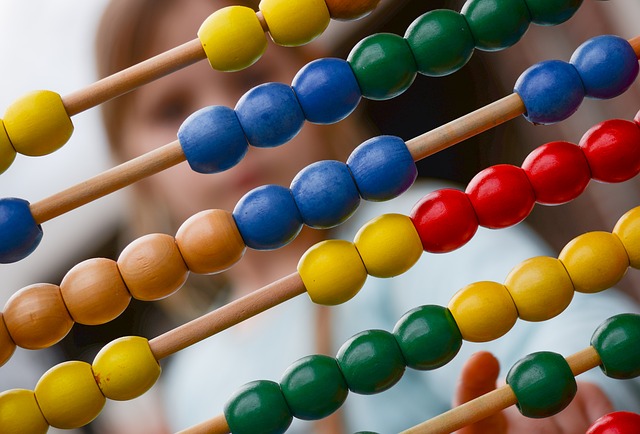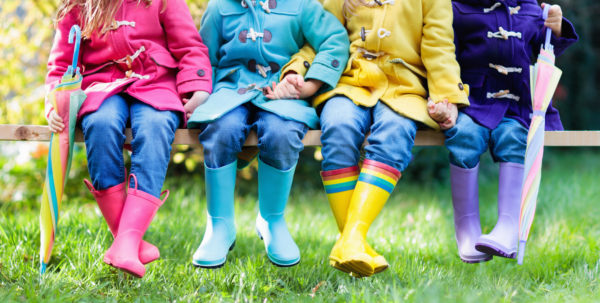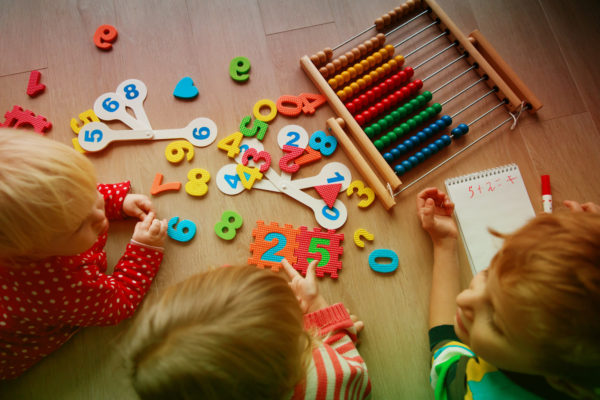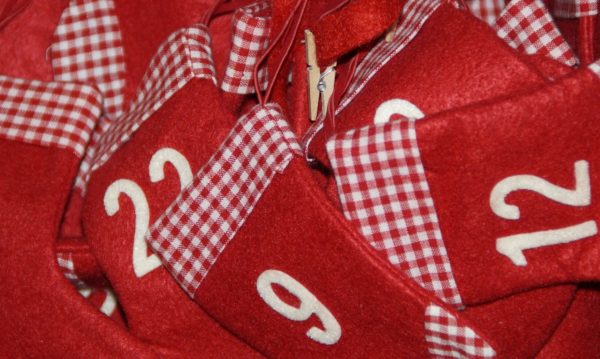Fun Math Games: 3 Stages to Learning Early Math Skills
In the early years there is a tendency for parents to place too much emphasis on teaching their children to read. Of course, reading and phonics is an essential topic, but introducing maths at an early age is also very important. Early maths skills set the stage for mathematical learning in the future.
It can be hard to keep preschoolers interested in maths topics, so the challenge is to make maths fun and interactive. If you are creative and make use of everyday objects, children won’t even know they are learning key maths skills.
Teaching early maths skills at home needs to involve a lot of sensory play. By engaging and stimulating the five senses (sight, smell, sound, taste & touch) through maths and number investigations, children will be learning and having fun at the same time.
It is so important at this age to remember that children’s senses are still developing. Each new sensory experience will build pathways of nerves, increasing their ability to complete more complex learning tasks. The growth that is encouraged through sensory play enhances children’s senses, and these, in turn, make them better able to use their senses for learning.
The starting point for preschool maths is to help children learn number skills in a step-by-step process. This can easily be done at home, in the form of games and activities, rather than formal learning. Using physical objects (known as ‘manipulatives’) such as beads, blocks, buttons, food or just about anything you can find around the house, can be used to practise counting, grouping, adding and subtracting. Here are the steps you need to follow:
1 . Encourage number recognition with fun math games
At preschool age, number recognition is the first step to teaching maths skills. Can the child recognise the number and remember its name. As always, repetition is key to the retention of knowledge. Start with numbers 0-5 and work towards 10.

Dry penne pasta threaded with string makes a useful tool for shaping numbers.
The first step is recognizing the numbers and remembering their names, starting with 0 – 5 and working up to 10. By the age of two and a half to three, children begin to understand what a number is although they will still mix them up frequently. The best way to encourage number recognition is to focus on the shapes of the numbers by writing and creating them in different formats using a variety of materials.
Using materials around your house, you will be able to create sensory experiences while focusing on the shape of the numbers and how to write
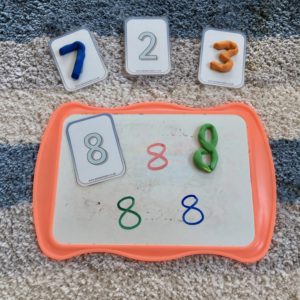
Use playdough to focus on number shapes.
them in many different ways. Dry penne pasta can be a useful tool when making letter shapes while play dough is always an old sensory favourite when it comes to forming number shapes and using fine motor skills. Other materials such as popsicle sticks for making number shapes can be useful. Also, it is important that children can recognize numbers in any writing so play a game matching typed number cards with written numbers to reinforce their familiarity with each shape.
2. Focus on one to one correspondence
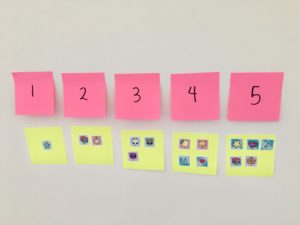
Matching stickers with numerals reinforces one to one correspondence.
By three years of age, children begin to understand one to one correspondence, meaning that they can count objects and understand that two objects = 2. At this stage, counting may still be tricky for some children as they may skip objects or numbers while counting. Again, repetition is key – the more opportunities for kids to practice these skills, the easier it becomes. Laying out objects in lines and rows helps children to count carefully without skipping items. Use an ice cube tray or egg carton can help with one on one

An ice cube tray is great for sorting out objects to be counted.
correspondence skills. Encourage your kids to count the squares in order, from left to right and top
to bottom just as we do with reading. You can use a Tens Frame to help organize objects. This is a simple grid with two rows of five. This helps young minds keep track of their counting but something as simple as an ice cube tray or an egg carton can also help them to organize what they

Sort different numbers of objects to match numerals.
are counting. Also, utilize your child’s toys for fun matching games. Can they match three blocks with the number 3? Can they match five coloured pencils with the number 5? Simple games played every day will make math fun and increase their confidence with numbers. Counting objects accurately and understanding the meaning of numbers is a big step for young children and it does take time. Remember to practice frequently and don’t feel discouraged if your child takes some time to pick up this concept.
3. Introduce simple adding and subtracting
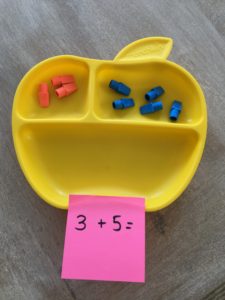
Use a divided plate for adding, count each object into the bottom section.
Once children have a solid grasp of what numbers are and what they represent, then they are ready to start to comprehend the concept of addition and subtraction. It is

Your child’s toys can participate in math stories as well!
better to introduce these topics separately, so you child doesn’t get confused and addition is always the most natural starting point. Use what you have at home for manipulatives, you don’t need to spend a lot of money to create useful resources. Dry pasta, coins or sweets can be used for simple adding games. Hide anumber of objects in both hands, revealing one at a time. Ask your child to count them altogether. Reinforce by writing the sum on paper or on a whiteboard so you child can see how it is laid out and begin to recognize an “equals” sign. Always use the correct vocabulary when teaching addition, “2 plus 2 equals a sum of 4”. The more repetition of these terms, the easier your child will pick up the appropriate vocabulary. After practicing the concept of addition for at least 3 weeks, begin by introducing subtraction in similar ways. The key question with subtraction is “how many are left?” which lends itself well to story problems. Again, use interesting manipulatives you have on hand. Stuffed toys can act as characters. “There are 5 M&Ms on the table but Teddy eats 2 of them. How many are left?” After solving the problem, write down the math sentence on a whiteboard or paper to reinforce the number sentence form of the math problem.
Enjoy and have fun with math games at home!
Remember that you do not need complicated or expensive manipulatives to create a sensory mathematical learning experience for your child. Fun math games for preschoolers can be created anywhere. Remember that if you are short on time or teaching away from home, fingers work well when beginning to add and subtract and a plain paper or whiteboard can be used to draw pictures to solve equations. The most important thing to remember is that kids will benefit from daily experiences involving number and the more you practice, the more natural they will become at understanding the world though a mathematical perspective.
